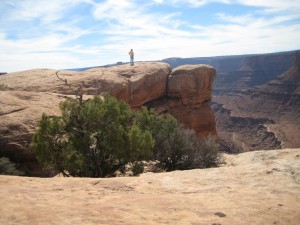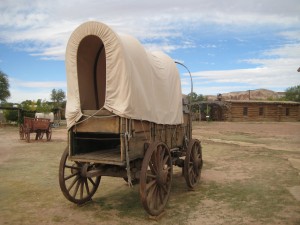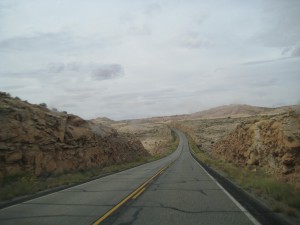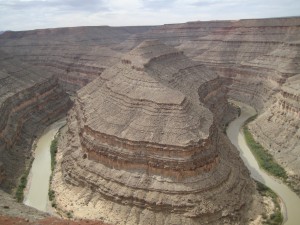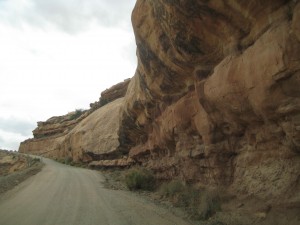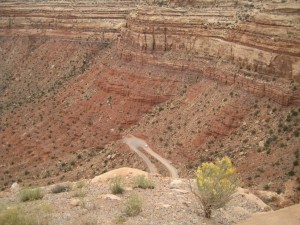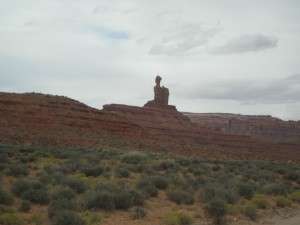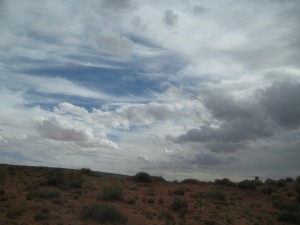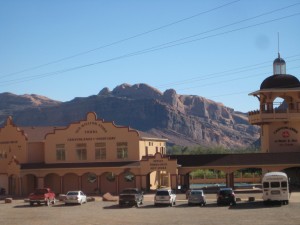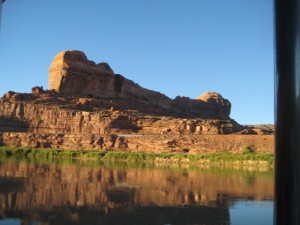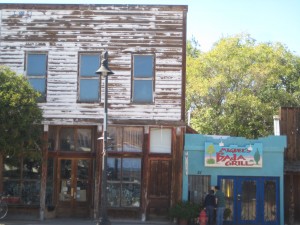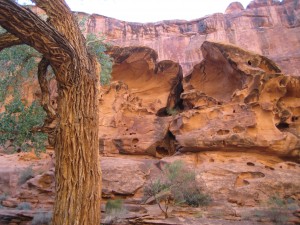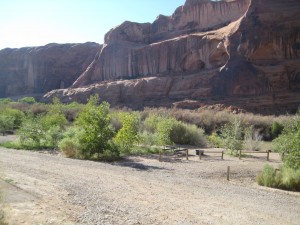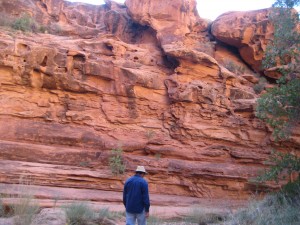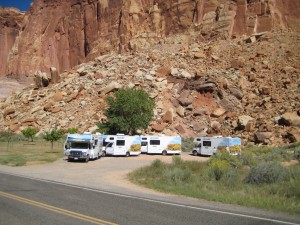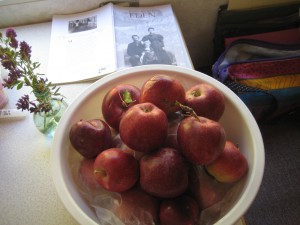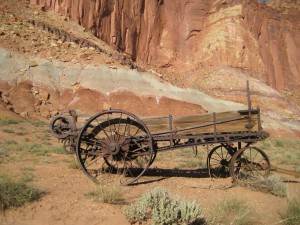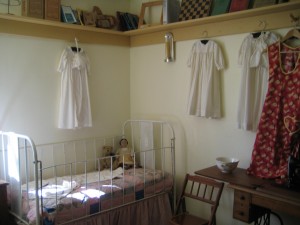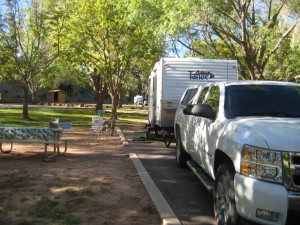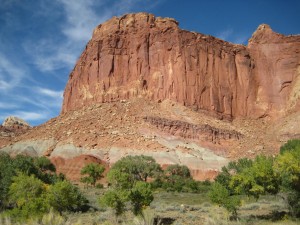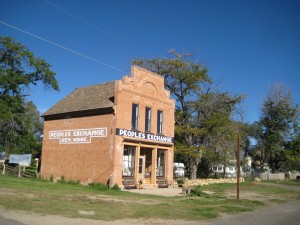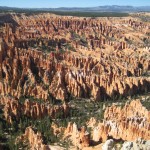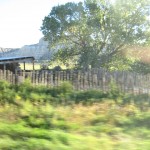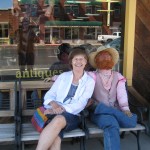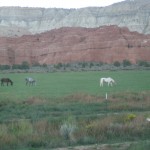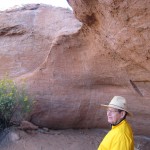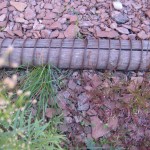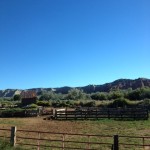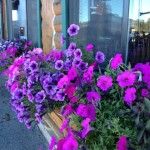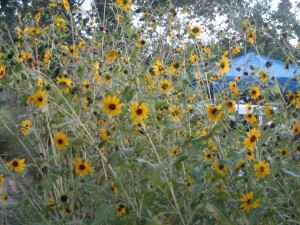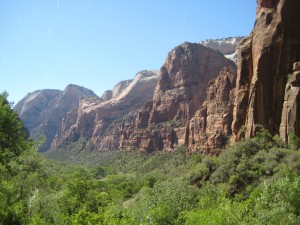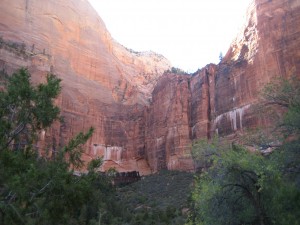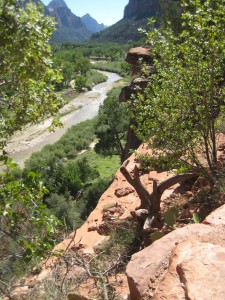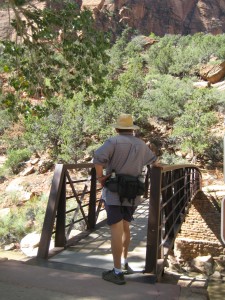Phil and Karla. At the Bryce Cannonville KOA, a rig pulled in to the spot next to ours on a stormy, cloudy day. I said hello to the new RV neighbors as I ran to the laundry room to do wash. Before long Phil (as we later learned) called out to our trailer inviting Bill to join the men in solving a mechanical problem. Turns out his hitch was attached to the ball and was stuck so that Phil was unable to unhook. It took three men about two hours to solve the problem and by that time they bonded as fellow members of the military.
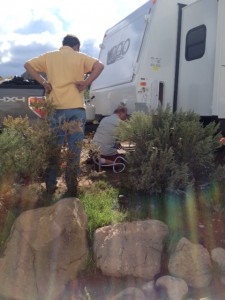 Bill ponders Phil’s trailer problem
Bill ponders Phil’s trailer problem Three heads are better than one
Three heads are better than one
The men disassembled the hitch, cut the electrical, and reassembled. Later Phil invited us to join he and his wife for dinner in town. A great idea, I thought. Phil was gregarious and Karla was quieter and supportive. We chatted through dinner like old friends. Afterwards we got a tour of Phil and Karla’s trailer. We finally retired for the night, only to have Phil knocking on the door to loan us a DVD, Trimuph of the Nerds because we mentioned we were listening to the Steve Jobs story. It was hard to say goodbye the next day. I really enjoyed our time with Phil and Carla.
Turns out we didn’t have to say goodbye. Our next stop was Kodachrome Basin State Park and Phil and Carla drove over in the afternoon and we sat in our trailer and chatted most of the afternoon. There were from the Austin, Texas, area and had been married one year longer than us. We exchanged emails and promised if we were ever in Austin or if they were ever in Palm Desert, we would look each other up.
Goblin Valley is a unique, small State Park off the beaten path.  Campsite, Goblin Valley State Park
Campsite, Goblin Valley State Park
You drive 12 miles off the highway and you are in the middle of nowhere. There is so little out by Goblin Valley you will find wild, open space, goblins, a small visitors center and a 25-site campground.
 Goblin Valley
Goblin Valley
There are several trails and Goblin Valley with its stone gnomes and uniquely shaped goblins.
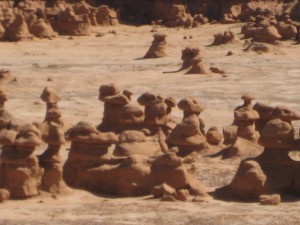 Goblin Valley Closeup
Goblin Valley Closeup
You should be able to hear a pin drop in this isolated camp; however, because of the lack of background noise, sound carries so if there are people laughing and talking in one part of the camp, it sounds like there is an entire regiment of people merrymaking. You should also be able to do some serious stargazing, which you can do providing the campers keep their lights to a minimum.
 Camp at Goblin Valley State Park
Camp at Goblin Valley State Park
There are very few large trees or bushes which contributes to the traveling of sound and light between camps. The Valley of Goblins is so unique and visitors can wander for hours among the strange shapes or have a picnic overlooking the valley.
 Goblins
Goblins
Dead Horse Point State Park is another state park that became very popular in light of the Federal Government shutdown. We were fortunate to have a one-night reservation. Because the Grand Canyon was also closed, we were grateful to have a chance to see breathtaking canyons.
The campground has only 21 sites, but the Park has an extensive visitor center and plenty of hikes. We chose the Big Horn Overlook which we could hike from our camp. The views on this hike were spectacular. Later a ranger told us that the views from this trail are the same ones that Canyonlands visitors see. At the end of the trail, a crevice with dropoffs on each side blocked the last overlook. It was a pretty easy jump, except if you looked down because then your heart would get stuck in your throat envisioning how far you could fall. Because I am not a Big Horn sheep, I declined, but Bill jumped. On the rocks, Bill chatted a group from Lake Tahoe.
 West Rim Trail, Dead Horse State Park
West Rim Trail, Dead Horse State Park
From our camp, we could bike to Dead Horse Point and this was another spectacular view of canyons. We were grateful and decided we didn’t have to feel deprived about not seeing the Grand Canyon. There are also nine miles of mountain biking trails, which we did not get to explore. Instead in the morning we rode our bikes back out to Dead Horse Point for another look at the canyons before hitching up.
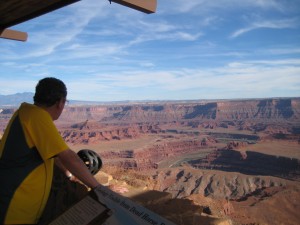 Dead Horse Point overlook
Dead Horse Point overlook
 Bike rider on the trail
Bike rider on the trail
Blanding is another small town, population 3,600, along Hwy. 191. Many of the Mormon pioneer families that originally settled in Bluff ended up moving to Blanding, which was slightly more hospitable. The town sits at an elevation of 6000 feet. The Blanding Visitors Center and pioneer museum hold more fascinating history about the Hole-in-the-Rock settlers.
Edge of the Cedars State Park and Museum make for an interesting afternoon learning about the ancient Puebloan culture.
 Connie descending 1000 year-old-kiva
Connie descending 1000 year-old-kiva
 Ladder to enter and exit kiva
Ladder to enter and exit kiva
My favorite was getting to climb down a ladder into a Kiva, the dwelling structure built underground where the Indians lived. It was dark, with a dirt floor, no windows, and since it had recently rained, puddles to step around. The Kiva made me so grateful for my cozy trailer home. Emerging from the Kiva to blue sky was joyful, like breathing again after being in a stifling room. I couldn’t imagine living under the shelter of a Kiva.

Blanding has a Dinosaur Museum but we didn’t have time for that.
The state government of Utah decided to pony up the money to open their parks the day we visited Blanding so we took the road from Blanding to Natural Bridges National Monument, a 30 to 40-minute drive through high desert. A sign on the Visitors Center said “Welcome back” but it was not open. The park, however, was open.
 Entrance to Natural Bridges
Entrance to Natural Bridges
 Can you see the natural bridge?
Can you see the natural bridge?
There is a nine-mile drive with overlooks, so the Park makes it very convenient to see a lot from your automobile. But to really experience the Park, hiking the trails to the bridges, along the canyon bottom and on the Mesa tops is the ideal way to explore.
We did run into a friendly group of young people from Holland at Natural Bridges that were trying to help a hiker who had sprained her ankle at the bottom of the canyon. The Holland group did not know the sprained-ankle girl but were asking us if we had tape to bind her ankle and were going to hike down with the tape. Bill found an old, mangled box of tape in the bottom of his first aid kit and we sent it along. As we were leaving, the sprained-ankle girl emerged hopping on one foot, holding onto to several hikers and the Holland hiker returned our tape. I thought the Holland group was very thoughtful to stop their hike to help a stranger. The Hollanders were on a visit to see the National Parks but didn’t complain about not getting to see them. Instead, they told us about all the places they had been able to visit instead. It sure does make your day to run into positive, thoughtful friendly people.



